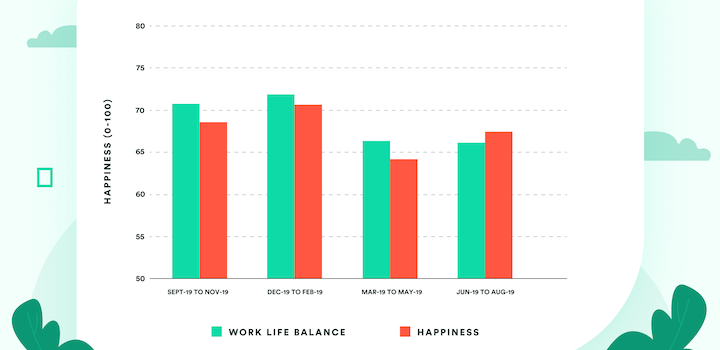
Could you be happier at work?
Take our quiz and find out! It takes just five minutes and you'll get a data-packed report afterwards.
Finding the Right Work-Life Balance
Friday Pulse has always been about making the world of work better. However, recently things have made it difficult for everyone (even us) to find the right balance in work/life. Working from home is the new normal for many, and yet it comes with a cost. Work-life balance has not improved.

Our data confirms this: work-life balance has deteriorated across all of our clients and isn’t bouncing back.
A poor work-life balance is a strong predictor of burn out, as well as long-term loss of productivity and innovation. It is a critical metric for businesses to track and is one of the 15 topics that we measure in our quarterly Culture Profile for clients.
Here at Friday Pulse, our score dropped dramatically from a pre-COVID average of 88 to a score of 67, as the outbreak continued. Our score was high because it’s a topic we take seriously – we encourage employees only to work 40 hours a week, and to take their holidays.
But the pandemic has made this all much harder. So, we have decided to do something many will find radical – we are switching to a four-day working week.
This is a solution that will not suit everyone. However, we do think every business should be thinking hard about finding their ‘right balance.’ There is a long way to go before the return of normality and that “next normal” will be different regardless, in many significant ways – one of which will inevitably be more working from home.
In this post, you’ll see how a four-day workweek could help you. Again, it’s not a solution for everyone, but it might be the drastic shift that your organization needs to think about.
First, a look at some data.
The Impact of COVID-19 on Work-Life Balance

In the chart above, you can see that across all of our clients, the average work-life balance score was 72 before lockdown, which then dropped to 66. Even now, while happiness scores are improving, work-life balance scores have not improved.
It’s been a few months since those darkest times but the whole course of events started us thinking: what could we improve?
It was a podcast featuring Alex Soojung Kim Pang, author of Shorter: How Working Less Will Revolutionise the Way Your Company Gets Things Done, that was inspirational to our Founder & CEO, Nic Marks in answering this question.
What a Four-day Workweek Can do For You
A four-day workweek is somewhat radical, but not a new thing. A growing number of firms in the UK and internationally are experimenting with the format. It’s not limited to spunky start-ups either. Companies like Microsoft in Japan switched to a four-day schedule and found a 40% increase in productivity and a 23% decrease in electricity use. Even countries like New Zealand and Finland have suggested employers switch to the four-day work week to address persistent work-life balance issues.
There are different ways of approaching a four-day week. While some firms opt for a compressed schedule that squeezes a 40-hour week into four days, we are adopting a ‘true’ four-day workweek means that employees’ clock in 32 hours each week. Yes, there is less time to work with, but the benefits are immediate.
More time for you
Time is one of our most valuable commodities. A shorter workweek means more time. All the salary in the world doesn’t compensate for lost time. In our busy world and schedules (especially with uncertainty around schooling for children), time means families can juggle childcare and work much better.
Shorter workdays also reduce the number of sick days taken and having a three-day weekend every week is essentially an additional 52 days of time off. So, what kind of effect does all that time have on people?
More focus
With “less” time to get things done, employees are more focused and companies can reap a bump in productivity right away. Work becomes less of a ‘face time’ affair and is respectful of people’s time. Meetings are on point. With extra rest and leisure time, people aren’t limping to the finish line on a Friday afternoon.
Reducing the carbon footprint
While many companies are still working from home, a reduced workweek also reduces the costs of running the office and commuting – and let’s be honest, a lot of time is wasted in the office. Without this, overhead costs should go down together with reduced environmental impact. Just the sort of win-win situation Nic covered in his TED talk 10 years ago.
Are You Ready For a Four-day Workweek?
Not every company is ready for a transition into a four-day workweek. However, here are some of the considerations we went through in deciding if we were ready. We hope these policies help you as you think about the transition.
Keeping track of time
The question we had to answer was, “how do we spend our workday?” Time is the most precious commodity in a four-day week. When we were trying to make this decision, we kept time diaries to track how we were spending our time. We looked at what was essential, what added the most value, and what kind of downtime we had.
Trim the fat
What could we cut? Concerned with efficiency and productivity, we looked at the length of meetings, how we could give people uninterrupted time to work, and the activities that added the most value.
As a result, we’ve reduced the number of meetings we’re having. We’re also capping the number of people in a meeting to make sure that it’s more focused and we’re getting the most interaction out of people.
Rotating schedule and Communication
One thing we wanted to make sure we continued was our quality of service to customers, every day of the working week. It’s clear that not everyone can have a Friday off — some would have to have Mondays or other days off, instead.
To make things easier on ourselves, we settled on what channels we were going to use to communicate with each other and who would be “on-call” if anything happened. To ensure that people had time to focus on their work instead of fielding questions all day, we determined an ‘office hours’ set up for everyone that they were available and online to answer questions and interruptions.
Join Us on this Adventure
Like many of you, we’re working on improving our happiness scores. Over the next few months, we’ll be paying careful attention to the impact of a four-day working week on our happiness and work-life scores on the Friday Pulse platform. We’ll be reporting back in the next few months to discuss the things we learned from this transition.